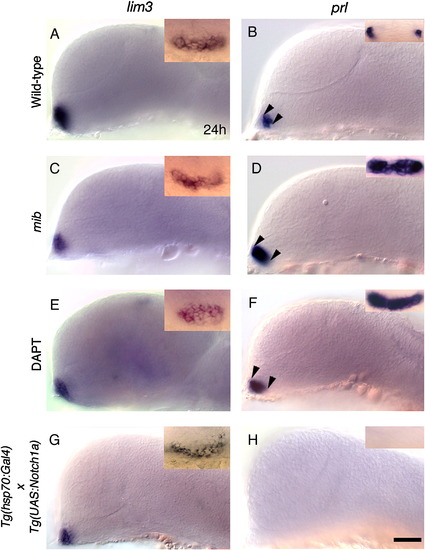Fig. 3
- ID
- ZDB-FIG-080715-37
- Publication
- Dutta et al., 2008 - Notch signaling regulates endocrine cell specification in the zebrafish anterior pituitary
- Other Figures
- All Figure Page
- Back to All Figure Page
|
Notch is necessary and sufficient to restrict lactotrope differentiation in the anterior pituitary placode. (A, B) Wild-type embryos labeled with lim3 (A, n = 85) and prl (B, n = 96). (B, inset) Bilateral cells in the anterior pituitary placode express prl. Gene expression in DMSO treated (n = 30), and hsp70:Gal4 heat-shocked (n = 30) control embryos was similar to wild-type embryos in A and B. (A, C, E, G) Pituitary placode size and lim3 expression in mib mutant (C, n = 39), in DAPT treated (E, n = 45), and in heat-shocked hsp70:Gal4 × UAS:notch1a (G, n = 22) transgenic embryos is similar to controls (A, B). (B, D, F) Loss of functional Notch signaling in mib mutant (D, inset, n = 37/37) and DAPT treated (F, inset, n = 32/40) embryos lead to expansion of prl in pituitary placode (arrowheads; D, F). (H) prl expression in the anterior pituitary placode is completely lost in hsp70:Gal4 x UAS:notch1a transgenic embryos (n = 48/48) following heat shock. (A–G) side views, anterior to the left, dorsal to the top; (A–G, inset) frontal views, dorsal to the top. All embryos Prim-5 (24 h) stage. Scale bar: 50 μm (A–H); Insets A, C, E, G: 40 μm; Insets B, D, F, H: 30 μm. |
| Genes: | |
|---|---|
| Fish: | |
| Conditions: | |
| Anatomical Term: | |
| Stage: | Prim-5 |
Reprinted from Developmental Biology, 319(2), Dutta, S., Dietrich, J.E., Westerfield, M., and Varga, Z.M., Notch signaling regulates endocrine cell specification in the zebrafish anterior pituitary, 248-257, Copyright (2008) with permission from Elsevier. Full text @ Dev. Biol.

